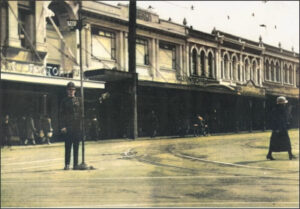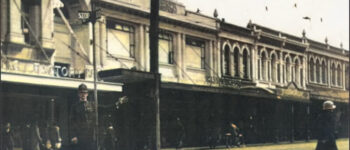1922: First Traffic Signals
May 22, 2023
By AHNZ

Today in Auckland history, 22 May, 1922, New Zealand’s first traffic signals were put to use. Prior to this the state of the art technology would have been the pair of white gloves a police constable on point duty wore to draw attention to his hand signals. The “ingenious” signal poles were placed at the 5 principle intersections with white words “STOP” and “GO” against a red background. These were Queen and Customs Streets, Queen and Wellesley Streets, Karangahape Road and Pitt Street, Karangahape Road and Symonds Street, and Symonds Street and Khyber Pass Road.
As an appreciator of Thomas Hobbes famous Leviathan (1651) and Herbert Spencer’s The Social Organism (1860) it’s of interest to the student of the logos whenever the New Zealand organism makes an evolutionary jump like this one. Our traffic communications in Auckland had evidently reached a critical point where a new organising force needed to be adopted. It’s also an indication that if we think of Auckland as a large corporate organism we can identify 5 points in its anatomy representing major ‘blood’ vessels.
It was not until the 1947 that electric traffic lights came to Auckland and by the 2020s, of course, we have a vast network of transistors telling us what to do at all hours whether we need them to not. New Zealand’s corporate nervous system did not have to evolve this way by necessity. In some countries such as Vietnam, Thailand, India etc. there are few or no traffic lights yet there are complex traffic organising problems that need to be solved. And, they are. Likewise, whenever lights fail in New Zealand we all find ways to give everyone space and time to negotiate intersections and it doesn’t lead to traffic jams or collisions. It may even be that the Spontanious Order of flashing orange traffic light failures represent a safer and more efficient solution just as Bob Jones has been trying to tell us for years.
“An ingenious device for regulating traffic made its appearance at five principal intersections in the city to-day. It is simplicity itself, comprising a rod attached to a tramway pole or fitted into a socket in the ground. At the top of the rod are four arms at right angles to each other and facing the four approaches made by the intersection of the street” – A NOVEL DEVICE, Auckland Star (22/5/1922,) Papers Past
“The new traffic indicators at street intersections were discussed by the committee of the Auckland Automobile Association last evening. A correspondent wrote maintaining that the indicators did not perform the desired work, and they were really death traps, as the same signal applied to two lots of traffic.” – New Zealand Herald (22/8/1922)
“Believe what you want. These walls are funny. First, you hate ‘em, then you get used to ‘em. After long enough, you get so you depend on ‘em. That’s ‘institutionalized.’” – Shawshank Redemption (1994)
“Artists grow up overprotected by adults preoccupied with the Crisis, come of age as the socialized and conformist young adults of a post-Crisis world” – Strauss–Howe generational theory, Wiki
Something about the dominant mentality in the West dictates that Spontanious Order must not be relied upon to regulate our traffic. Your own human judgement was considered inferior to a State actor in the form of policeman and, later, inferior even to a mindless timing circuit. We are expected to sit patiently in our cars at midnight as the only car in the street and the only person awake in a small town while a little red light counts the milliseconds until our release. To the free thinking this is stressful and infuriating but to the Collectivist this situation is relaxing and nurturing. I once met a man raised in East Berlin who refused to cross a street until a little Green Man picture told him he could despite the streets being totally deserted apart from ourselves!
 My suggestion is that the more free-wheeling and Spontanious Order Kiwis emerged from the post-war meat grinder a told-what-to-do nation. The most spontanious thinkers were put behind barbed wire in Contentious Objectors camps. Young people were subjected to compulsory Basic Training in following orders mindlessly then shipped off to be traumatised in the Eastern and/or Western Fronts. After that culture shock our 1920s ancestors, those who were adults and older, who ran the world, anyway, were desperate to have orders to follow. They had been institutionalised to the point of craving someone or even something (a microcircuit!) to tell them it was OK to cross the street.
My suggestion is that the more free-wheeling and Spontanious Order Kiwis emerged from the post-war meat grinder a told-what-to-do nation. The most spontanious thinkers were put behind barbed wire in Contentious Objectors camps. Young people were subjected to compulsory Basic Training in following orders mindlessly then shipped off to be traumatised in the Eastern and/or Western Fronts. After that culture shock our 1920s ancestors, those who were adults and older, who ran the world, anyway, were desperate to have orders to follow. They had been institutionalised to the point of craving someone or even something (a microcircuit!) to tell them it was OK to cross the street.
So, no wonder this occurred in 1922 and in Auckland. Also we can see what kind of world our Silent Generation grew up in. As an Artist Generation they were overprotected, highly socialised, and conformist. It would take the Boomer Generation to come along and push back against this highly structured world which James K. Baxter referred to as “the concrete playground.”
—
Image ref. Mercury Theatre history, James D Richardson Collection, Auckland Libraries Heritage collections; Colourised a little by AHNZ (2023)
 Like Comment Share
Like Comment Share





